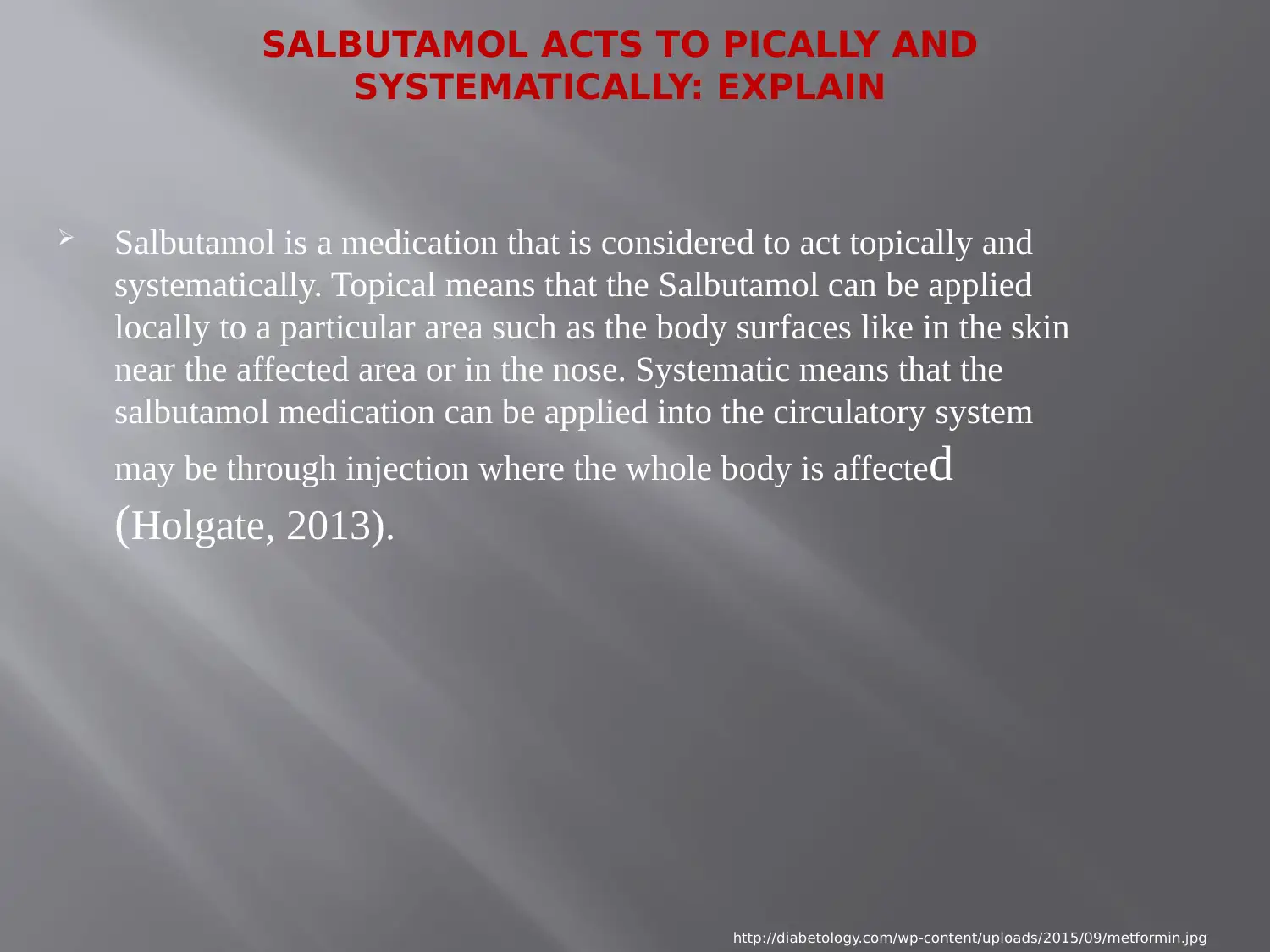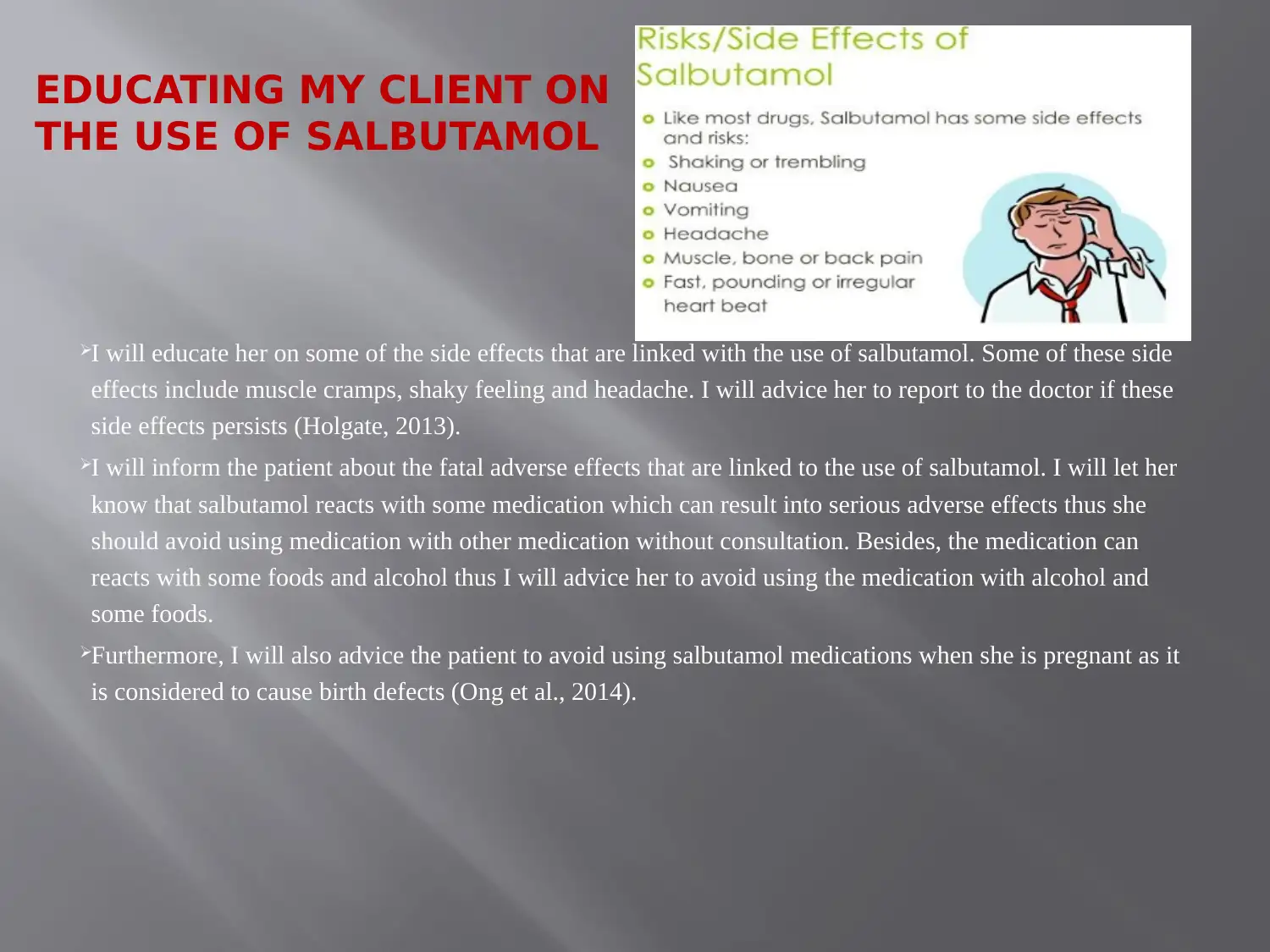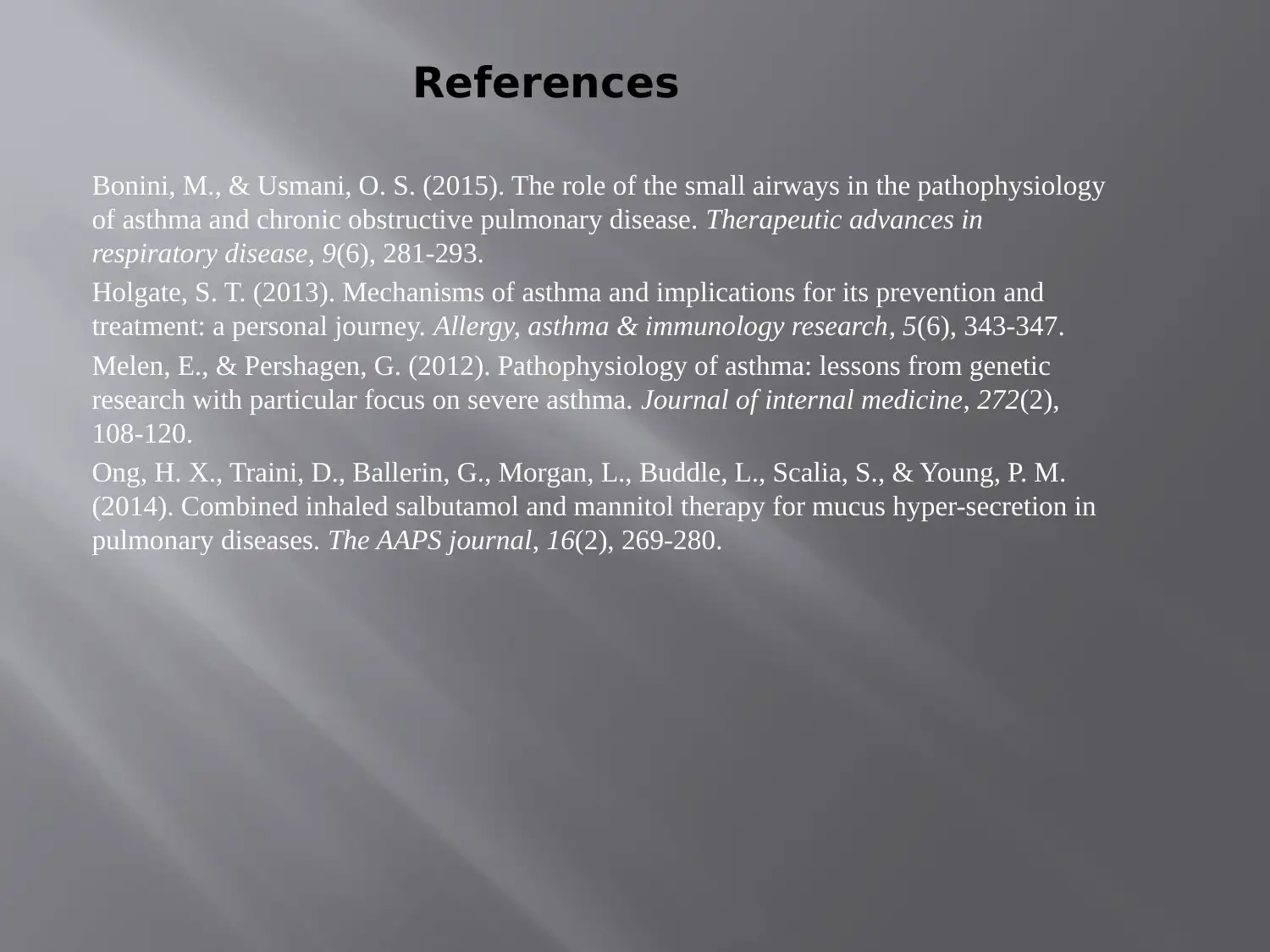Asthma Pathophysiology, Clinical Manifestations and Salbutamol
VerifiedAdded on 2022/09/27
|7
|991
|29
Presentation
AI Summary
This presentation examines the pathophysiology and pharmacological management of asthma, focusing on a patient named Sasha. It details two major pathological changes: bronchial smooth muscle contraction and increased mucus production, explaining how these contribute to airway narrowing and inflammation. The presentation also covers clinical manifestations like coughing and increased respiratory rate. Salbutamol is proposed as a key medication, with its mechanism of action as a short-acting beta-2 agonist discussed. The presentation further explores topical and systematic applications of Salbutamol and provides guidance on educating patients about potential side effects, adverse reactions, and medication interactions, including advice to avoid use during pregnancy. The presentation is a part of the BIOL122 assignment at Australian Catholic University.

MEET SASHA
Client Information
Name Sasha Jacob
Gender Female
Age 22 years
Weight Obesity
Disease
condition
Asthma
Lifestyle Balanced diet
Occupation Nursing student
Living status Lives with her grandmother
Exercise N/A
Smoking Does not smoke
Alcohol intake She drinks wines
Family history Father died of heart failure
Medication Salbutamol twice a day
Client Information
Name Sasha Jacob
Gender Female
Age 22 years
Weight Obesity
Disease
condition
Asthma
Lifestyle Balanced diet
Occupation Nursing student
Living status Lives with her grandmother
Exercise N/A
Smoking Does not smoke
Alcohol intake She drinks wines
Family history Father died of heart failure
Medication Salbutamol twice a day
Paraphrase This Document
Need a fresh take? Get an instant paraphrase of this document with our AI Paraphraser

2 MAJOR PATHOLOGICAL CHANGES
IN PATIENT WITH ASTHMA
Bronchial Smooth muscle contraction
Bronchial smooth muscle contraction is a characteristic feature of
pathophysiology of asthma. Bronchial smooth muscle contraction induces
airway narrowing, which also contributes to bronchial inflammation by
releasing various inflammatory mediators. Such inflammatory mediators
may include mast cells and T-lymphocytes . The increase in bronchial
smooth muscle contraction when Asha has asthma will be as a result of the
deposition of extracellular matrix proteins. Besides, an increase in bronchial
smooth muscle contraction will be contributed by an increase in both cell
size and number. Furthermore, asthmatic bronchial smooth muscle
contraction will be as a result of increased cell proliferation and decreased
cell apoptosis (Melen & Pershagen, 2012).
Increased mucus production
Increased secretion of mucus is related to asthma. The increase in mucous
production is associated with activation of inflammatory response. The
activation of EGFR inhibits epithelial cell apoptosis, thereby allowing IL- to
IN PATIENT WITH ASTHMA
Bronchial Smooth muscle contraction
Bronchial smooth muscle contraction is a characteristic feature of
pathophysiology of asthma. Bronchial smooth muscle contraction induces
airway narrowing, which also contributes to bronchial inflammation by
releasing various inflammatory mediators. Such inflammatory mediators
may include mast cells and T-lymphocytes . The increase in bronchial
smooth muscle contraction when Asha has asthma will be as a result of the
deposition of extracellular matrix proteins. Besides, an increase in bronchial
smooth muscle contraction will be contributed by an increase in both cell
size and number. Furthermore, asthmatic bronchial smooth muscle
contraction will be as a result of increased cell proliferation and decreased
cell apoptosis (Melen & Pershagen, 2012).
Increased mucus production
Increased secretion of mucus is related to asthma. The increase in mucous
production is associated with activation of inflammatory response. The
activation of EGFR inhibits epithelial cell apoptosis, thereby allowing IL- to

THE CLINICAL MANIFESTATIONS OF ASTHMA
Coughing remain as one of the clinical manifestations of asthma. The asthmatic
bronchial smooth muscle contraction makes the airways in the lungs to become
affected, thereby becoming inflamed. Besides, the breathing tubes become reactive,
which makes them squeeze and tighten. This makes the lungs to be more likely to be
affected by foreign irritants like cold air. The body system then reacts by coughing in
efforts to try to remove the irritant in the lungs (Melen & Pershagen, 2012).
Increased respiratory rate is another major signs and symptoms of a patient with
asthma. The asthmatic bronchial smooth muscle contraction leads to inflammation of
the lungs and narrowing of the airways, which makes it hard for free passage of air in
the lungs. As a result, the air entering in the lungs decrease thereby making the patient
to take more breaths in a shorter period of time in order to provide the body with
enough oxygen required by the body to function well. This will make my client Sasha
to experience an increased rate of respiratory rate which is part of clinical
manifestation of Asthma.
Coughing remain as one of the clinical manifestations of asthma. The asthmatic
bronchial smooth muscle contraction makes the airways in the lungs to become
affected, thereby becoming inflamed. Besides, the breathing tubes become reactive,
which makes them squeeze and tighten. This makes the lungs to be more likely to be
affected by foreign irritants like cold air. The body system then reacts by coughing in
efforts to try to remove the irritant in the lungs (Melen & Pershagen, 2012).
Increased respiratory rate is another major signs and symptoms of a patient with
asthma. The asthmatic bronchial smooth muscle contraction leads to inflammation of
the lungs and narrowing of the airways, which makes it hard for free passage of air in
the lungs. As a result, the air entering in the lungs decrease thereby making the patient
to take more breaths in a shorter period of time in order to provide the body with
enough oxygen required by the body to function well. This will make my client Sasha
to experience an increased rate of respiratory rate which is part of clinical
manifestation of Asthma.
⊘ This is a preview!⊘
Do you want full access?
Subscribe today to unlock all pages.

Trusted by 1+ million students worldwide

Salbutamol will be my choice of medication that I will consider in the
management of my client’s asthmatic condition. Salbutamol is one of the
medication that is effectively used to control symptoms of asthma. It manages
asthma by allowing the airways to open thus making the patient to breath.
Furthermore, I will consider to use Salbutamol as relieves the symptoms of
asthma such as coughing and wheezing.
The mechanism of action- Salbutamol is a drug that acts as a short- acting beta
2 agonists in its mechanism. It binds on the active site of epinephrine which
stimulates the receptor. This causes the muscles in the airways to relax thus
allowing the airways to open (Holgate, 2013). The opening of the airways by
salbutamol medication makes will make it easy for my client to breathe thus
managing the symptoms of asthma.
SALBUTAMOL IN THE MANAGEMENT OF ASTHMA
management of my client’s asthmatic condition. Salbutamol is one of the
medication that is effectively used to control symptoms of asthma. It manages
asthma by allowing the airways to open thus making the patient to breath.
Furthermore, I will consider to use Salbutamol as relieves the symptoms of
asthma such as coughing and wheezing.
The mechanism of action- Salbutamol is a drug that acts as a short- acting beta
2 agonists in its mechanism. It binds on the active site of epinephrine which
stimulates the receptor. This causes the muscles in the airways to relax thus
allowing the airways to open (Holgate, 2013). The opening of the airways by
salbutamol medication makes will make it easy for my client to breathe thus
managing the symptoms of asthma.
SALBUTAMOL IN THE MANAGEMENT OF ASTHMA
Paraphrase This Document
Need a fresh take? Get an instant paraphrase of this document with our AI Paraphraser

SALBUTAMOL ACTS TO PICALLY AND
SYSTEMATICALLY: EXPLAIN
Salbutamol is a medication that is considered to act topically and
systematically. Topical means that the Salbutamol can be applied
locally to a particular area such as the body surfaces like in the skin
near the affected area or in the nose. Systematic means that the
salbutamol medication can be applied into the circulatory system
may be through injection where the whole body is affected
(Holgate, 2013).
http://diabetology.com/wp-content/uploads/2015/09/metformin.jpg
SYSTEMATICALLY: EXPLAIN
Salbutamol is a medication that is considered to act topically and
systematically. Topical means that the Salbutamol can be applied
locally to a particular area such as the body surfaces like in the skin
near the affected area or in the nose. Systematic means that the
salbutamol medication can be applied into the circulatory system
may be through injection where the whole body is affected
(Holgate, 2013).
http://diabetology.com/wp-content/uploads/2015/09/metformin.jpg

EDUCATING MY CLIENT ON
THE USE OF SALBUTAMOL
I will educate her on some of the side effects that are linked with the use of salbutamol. Some of these side
effects include muscle cramps, shaky feeling and headache. I will advice her to report to the doctor if these
side effects persists (Holgate, 2013).
I will inform the patient about the fatal adverse effects that are linked to the use of salbutamol. I will let her
know that salbutamol reacts with some medication which can result into serious adverse effects thus she
should avoid using medication with other medication without consultation. Besides, the medication can
reacts with some foods and alcohol thus I will advice her to avoid using the medication with alcohol and
some foods.
Furthermore, I will also advice the patient to avoid using salbutamol medications when she is pregnant as it
is considered to cause birth defects (Ong et al., 2014).
THE USE OF SALBUTAMOL
I will educate her on some of the side effects that are linked with the use of salbutamol. Some of these side
effects include muscle cramps, shaky feeling and headache. I will advice her to report to the doctor if these
side effects persists (Holgate, 2013).
I will inform the patient about the fatal adverse effects that are linked to the use of salbutamol. I will let her
know that salbutamol reacts with some medication which can result into serious adverse effects thus she
should avoid using medication with other medication without consultation. Besides, the medication can
reacts with some foods and alcohol thus I will advice her to avoid using the medication with alcohol and
some foods.
Furthermore, I will also advice the patient to avoid using salbutamol medications when she is pregnant as it
is considered to cause birth defects (Ong et al., 2014).
⊘ This is a preview!⊘
Do you want full access?
Subscribe today to unlock all pages.

Trusted by 1+ million students worldwide

References
Bonini, M., & Usmani, O. S. (2015). The role of the small airways in the pathophysiology
of asthma and chronic obstructive pulmonary disease. Therapeutic advances in
respiratory disease, 9(6), 281-293.
Holgate, S. T. (2013). Mechanisms of asthma and implications for its prevention and
treatment: a personal journey. Allergy, asthma & immunology research, 5(6), 343-347.
Melen, E., & Pershagen, G. (2012). Pathophysiology of asthma: lessons from genetic
research with particular focus on severe asthma. Journal of internal medicine, 272(2),
108-120.
Ong, H. X., Traini, D., Ballerin, G., Morgan, L., Buddle, L., Scalia, S., & Young, P. M.
(2014). Combined inhaled salbutamol and mannitol therapy for mucus hyper-secretion in
pulmonary diseases. The AAPS journal, 16(2), 269-280.
Bonini, M., & Usmani, O. S. (2015). The role of the small airways in the pathophysiology
of asthma and chronic obstructive pulmonary disease. Therapeutic advances in
respiratory disease, 9(6), 281-293.
Holgate, S. T. (2013). Mechanisms of asthma and implications for its prevention and
treatment: a personal journey. Allergy, asthma & immunology research, 5(6), 343-347.
Melen, E., & Pershagen, G. (2012). Pathophysiology of asthma: lessons from genetic
research with particular focus on severe asthma. Journal of internal medicine, 272(2),
108-120.
Ong, H. X., Traini, D., Ballerin, G., Morgan, L., Buddle, L., Scalia, S., & Young, P. M.
(2014). Combined inhaled salbutamol and mannitol therapy for mucus hyper-secretion in
pulmonary diseases. The AAPS journal, 16(2), 269-280.
1 out of 7
Related Documents
Your All-in-One AI-Powered Toolkit for Academic Success.
+13062052269
info@desklib.com
Available 24*7 on WhatsApp / Email
![[object Object]](/_next/static/media/star-bottom.7253800d.svg)
Unlock your academic potential
Copyright © 2020–2025 A2Z Services. All Rights Reserved. Developed and managed by ZUCOL.





